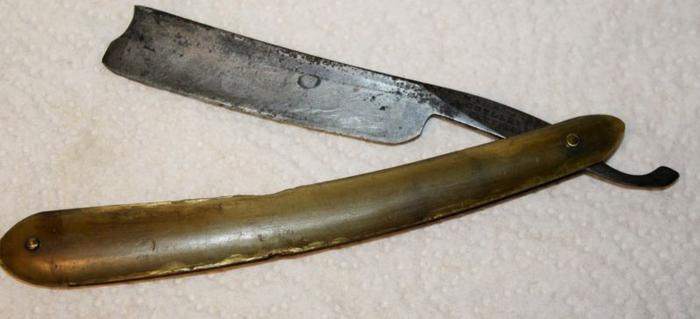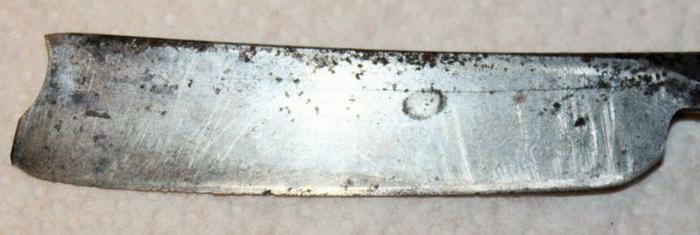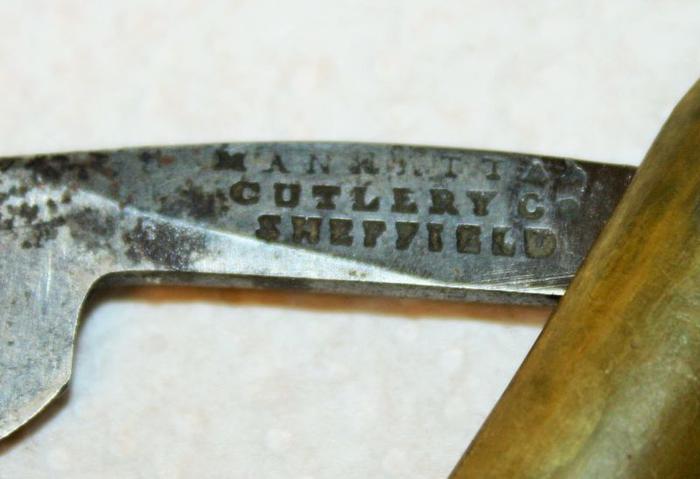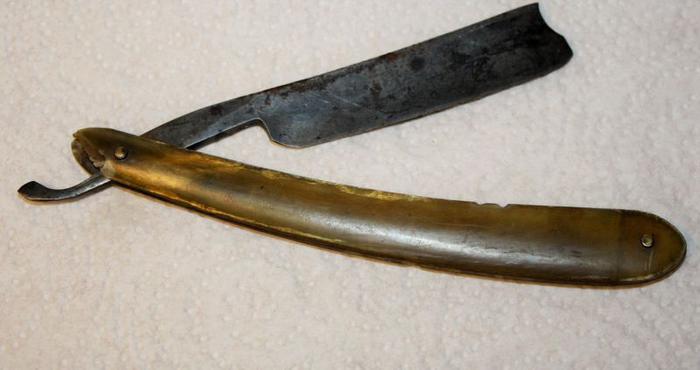Results 1 to 10 of 16
Thread: First Razor for Restoration!
-
09-28-2015, 07:12 PM #1Junior Member

- Join Date
- Sep 2015
- Location
- Michigan
- Posts
- 6
Thanked: 1 First Razor for Restoration!
First Razor for Restoration!
Hello everyone! This is my first post so I apologize if I have the wrong format or am in the wrong section. I recently purchased a Manhattan Cutlery Co. Sheffield razor as a $10 eBay find. I would be happy to hear the input of any more experienced restorers out there. Is this a good 1st razor to try and restore? Also, are these scales salvageable? I like the idea of keeping the razor as close to how it would have been from the maker, but those scales look pretty shot to me at least. I already have wet/dry sandpaper from 220-2000 grit, a electric buffer with several wheels, 6 polishing compounds from black emery to blue plastic polish, and i also have a decent set of hones. Just hoping to hear advise from some seasoned restorers. Also any information about this razor would be appreciated as I know Sheffield is generally regarded as good, but I know nothing of Manhattan Cutlery Co. I'm guessing late 1800's early 1900's based on a little searching? Thanks for any and all information.




-
09-28-2015, 07:51 PM #2The First Cut is the Deepest!


- Join Date
- Feb 2010
- Location
- Upper Middle Slobovia NY
- Posts
- 2,737
Thanked: 481
That's a fine first razor. 1891 or earlier?
Scales are rough, but still have life in them if you get creative.
BUT! I would REALLY recommend sticking to the hand sanding and skipping the buffing machine. Practice buffing on a JUNK blade before trying your hand on a nice old razor like this one.
I think you will be really surprised and pleased at how well this one is going to turn out with the basic hand powered restoration.
-
09-28-2015, 07:52 PM #3Senior Member




- Join Date
- Feb 2013
- Location
- Haida Gwaii, British Columbia, Canada
- Posts
- 14,457
Thanked: 4830
That is a tough one for a first restore. There is a thread currently that is all work in progress post by guys that are restoring some less than perfect candidates. It is not a bad one to follow along and perhaps join in. Those scales are save-able but they need a lot of work. I see nothing wrong with that as a first choice. It will be a lot of work. Most people would start with the easy fix er uppers and work their way to the tougher ones. http://straightrazorpalace.com/works...ed-wb-fbu.html
It's not what you know, it's who you take fishing!
-
The Following User Says Thank You to RezDog For This Useful Post:
Geezer (09-29-2015)
-
09-28-2015, 07:58 PM #4
-
09-28-2015, 07:59 PM #5Senior Member




- Join Date
- Feb 2013
- Location
- Haida Gwaii, British Columbia, Canada
- Posts
- 14,457
Thanked: 4830
That is a very true observation. Clean and functional is simple. All you need is steel wool and polish, oh and elbow grease is the most important part of all restores.
It's not what you know, it's who you take fishing!
-
09-28-2015, 08:16 PM #6

First...that is a nice blade that you have there. Manhattan Cutlery are very nice shavers. As both Rezdog and Magpie have already indicated, the blade appears that it can be restored to pristine, and the scales can be repaired and restored as well...BUT, it would require a lot of patience and work, not to mention techniques that just have to be learned. Better to clean it quickly, hone it, shave with it, and pick up a much easier candidate to start your restoration learning process. You'll always have this razor as a shaver until you develop the skills necessary to bring it back to where you really want it.
Of course...I never listened to good advice when starting out, sooooo...it's just my opinion now as a much older and wiser version of yesterday's me... Lupus Cohors - Appellant Mors !
Lupus Cohors - Appellant Mors !
-
The Following User Says Thank You to Wolfpack34 For This Useful Post:
Cmgrier1172 (09-28-2015)
-
09-28-2015, 08:47 PM #7

Wolfpack has it right!
Clean it up and restore a couple to learn some techniques of what will work and what doesn't.
It is a nice razor for sure and I would also advise NOT to use the buffer! (for now at least)
I too NEVER listened and ALWAYS seemed to take the hard road when learning stuff, so you can take my opinion and do with it what you may....

Ed
-
The Following User Says Thank You to Chevhead For This Useful Post:
Cmgrier1172 (09-29-2015)
-
09-28-2015, 09:16 PM #8Junior Member

- Join Date
- Sep 2015
- Location
- Michigan
- Posts
- 6
Thanked: 1
Thanks for the replies everyone. Being the bullheaded young man that I am, I'm going to try and restore this razor. I may practice my sanding on a $5 gold dollar first though. lol So start out at a low grit and proceed through to the 2000? I'm going to scrap the scales and start fresh as I don't believe I have the skills yet to tackle repairing them. Looks like I get to make my first set of scales with my first restore! Thanks for all the good advice and info on the razor!
Last edited by Cmgrier1172; 09-28-2015 at 09:18 PM.
-
09-28-2015, 11:11 PM #9Senior Member




- Join Date
- Feb 2013
- Location
- Haida Gwaii, British Columbia, Canada
- Posts
- 14,457
Thanked: 4830
Well if you would like to make new scales, be sure to save those ones. When doing restoration work you need to remember a few things. Slow and steady wins the race is quite important. Rush a restore and ruin a blade is what Glen told me and I can't gel but believe it was sounds advice. The other thing to think about is what you remove from the blade you cannot put back. Feel free to PM people with questions. I am currently restoring old scales that I removed early on, and looking for old blades with broken scales to fit my old ones. It's funny how thing circle around sometimes. Everyone that responded in this thread has done some very nice work when it comes to restores and may be a good resource for you when you have questions. You can always post another thread too.
It's not what you know, it's who you take fishing!
-
The Following 2 Users Say Thank You to RezDog For This Useful Post:
Cmgrier1172 (09-29-2015), Geezer (09-29-2015)
-
09-29-2015, 02:15 AM #10

Biggest help for hand sanding that I found was to take a block of wood and set some magnets in it with epoxy, then cover them with tape and attach your intended restore to it. You can also make various sand paper backers out f large art erasers. I also suggest using some sort of lubricant for sanding, it clears swarf and makes the sand paper dull less quickly. I use mineral oil for lube, though really anything will work.
-
The Following User Says Thank You to jfk742 For This Useful Post:
Cmgrier1172 (09-29-2015)


 31Likes
31Likes LinkBack URL
LinkBack URL About LinkBacks
About LinkBacks






 Reply With Quote
Reply With Quote





